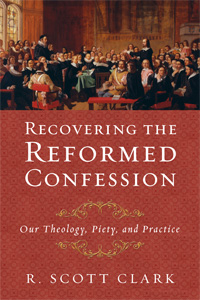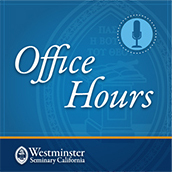W. Robert Godfrey has taught church history at the seminary level since 1974. As I like to point out, I was in Jr High (which was Middle School used to be called) when Bob started teaching. Antiquity, however, is useful in teaching . . . Continue reading →
Video: What Is the Heidelberg Catechism?
Mark Vander Pol is a graduate of Westminster Seminary California and a ruling elder at Christ United Reformed Church, Santee, California. The video was produced by Leon Brown, also a graduate of WSC. His YouTube channel is worth checking out. Mark gives . . . Continue reading →
In Case You Weren’t Sure What QIRE Means
The revival was marked by what were said to be great manifestations of the work of the Holy Spirit—speaking in tongues, ecstatic prophecies, miraculous healings and even the claim that somewhere around thirty people had been raised from the dead. Just . . . Continue reading →
The World is Watching: Cal Alumni Mag on Rushdoony
The theonomic and reconstruction movements pop up in the oddest places. I recall a PBS documentary in 1988 breathlessly hosted by Bill Moyers warning America about the dangers posed by the movements. Now, in the Fall 2012 issue of the alumni magazine . . . Continue reading →
Semi-Pelagianism and Faith as the Instrument of Existential-Mystical Union with Christ (Pt 3)
Part 2 That faith which secures eternal life; which unites us to Christ as living members of his body; which makes us the sons of God; which interests us in all the benefits of redemption; which works by love, and is fruitful . . . Continue reading →
Semi-Pelagianism and Faith as the Instrument of Existential-Mystical Union with Christ (Pt 2)
Last time we saw that, according to William Perkins, semi-Pelagianism asserts that the will (or other faculties) are able to operate in salvation partly on the basis of nature, i.e., they are not entirely dependent upon grace. In contrast, the Reformed argue . . . Continue reading →
The Growing Influence of the Anglican Tradition in Reformed Worship
Jonathan W. Williams writes, By “Anglican Tradition” I have in mind a number of elements that include but are not limited to the following: use of language from The Book of Common Prayer in the worship liturgy; corporate confessions of sin/declarations of pardon/absolution; weekly . . . Continue reading →
Toronto School Board Raises Rates on Churches By 800%
“The only thing I can think of is that they are trying to say they want the church out of here,” said Rev. Neil Zagala, who is the Secretary of the Ontario Filipino Fellowship. “Such a rent increase seems so out of . . . Continue reading →
Sometimes Culture Includes Cult
Leila writes: “My husband and I planned, from the beginning, to send our children to private school, since we weren’t happy with the public schools in our area. Right before our oldest was ready to start kindergarten in the mid-90s, a new . . . Continue reading →
Godfrey on Waldo and the Waldensians
For a time, the movement spread widely into parts of Germany and Austria, as well as Northern Italy. Persecution by the church, however, was severe and eventually reduced the movement to a remnant in the valleys of Northern Italy. Efforts to eradicate them through the centuries failed, and only in 1870 did the Waldensians receive full civil rights in Italy. [click image for more] Continue reading →
Church Order of Dort (1619)
The following is taken from Richard R. DeRidder, ed., The Church Orders of the Sixteenth Century Reformed Churches of the Netherlands Together with Their Social, Political, and Ecclesiastical Context. Trans. Richard R. DeRidder with the assistance of Peter H. Jonker and Rev. . . . Continue reading →
Semi-Pelagianism and Faith as the Instrument of Existential-Mystical Union with Christ (Pt 1)
William Perkins (1558-1602), in his 1595 Exposition of the Apostles’ Creed, on the question of effectual call, wrote: Againe, if the Vocation of every man be effectual, then faith must be common to all men either by nature, or by grace, or . . . Continue reading →
Was Jesus Married? Nothing to See Here.
UPDATE 09-21-12 21:09 Francis Watson suggests that the fragment is fake. The Guardian reports. UPDATE 9-19-12 17:20 Thanks to Ben (see below) for pointing us to a blog on this by Christian Askeland, who says that there are reasons to think that . . . Continue reading →
Office Hours: Union with Christ
Office Hours talks with John Fesko, Academic Dean and Professor of Systematic and Historical Theology at WSC, about his new book: Beyond Calvin: Union with Christ and Justfication in Early Modern Reformed Theology (1517-1700). There is some confusion about the Reformed doctrine . . . Continue reading →
What We Think We Know About Religion in America
The typical American adult pegs religious affiliation in the U.S. as follows: 24% Catholic, 20% Protestant, 19% unaffiliated, 9% Jewish, 9% atheist or agnostic, 7% Muslim, 7% Mormon, and 5% from all other religious groups. Continue reading →
A Useful Resource for Psalm Singing
So Psalm 58 invites us to have patience under persecution, to take comfort in the justice and judgment of God. Why? Because we know that that judgement – all the curses of Psalm 58 and the rest of the Bible – was borne for us by Christ. We, too, were children of the devil, deserving of all of this curse. But now, because that curse was carried for us, we know that when that last trumpet shall sound we will in Christ be found. So we need not fear the judgment. Rather, we look forward to it, knowing that finally God will be ultimately vindicated and glorified. Continue reading →
The Two Witnesses and Lampstands in Revelation 11
Bill asks, [C]ould you give me a quick answer to who the two witnesses are in Rev 11:3, and the identity of the two olive trees and two lamp stands in verse 4? Dear Bill, I understand the Revelation to have been . . . Continue reading →
Baptism and Circumcision According to Colossians 2:11–12
What follows is taken from a larger essay, “A Contemporary Reformed Defense of Infant Baptism:” What is the Connection Between Circumcision and Baptism? The connection between baptism and circumcision is quite clear in Colossians 2:11–12. The connection is not direct, but indirect . . . Continue reading →
Would Calvin Support the Occupy Movement?
Five years ago it was a leading premillennialist saying that were Calvin alive today he would, in effect, be John MacArthur. Now, the Secretary-General of the World Council of Reformed Churches, lecturing at Princeton Seminary (HT: Sovereign Grace News), claims that were Calvin . . . Continue reading →
7 Reasons Why P & R Churches Should Send Missionaries to Poland
Reaching Poland is critical to mission work in both western and eastern Europe. Yet Reformed Christians have ignored this reality for years and have neglected to send missionaries to this large European country. My goal here is to make the case for . . . Continue reading →

















